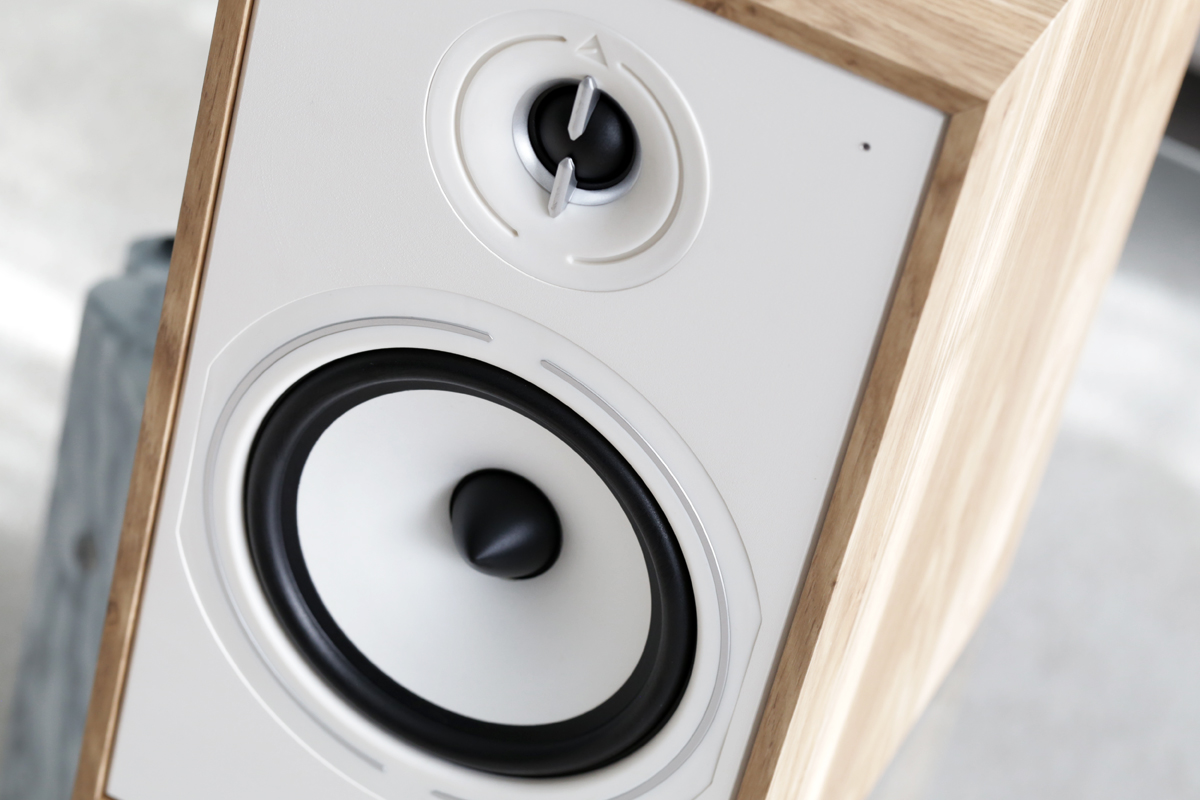 What would you expect to pay for a 60Wpc class-D amplifier with a built-in phono stage and Bluetooth receiver? $400? $500? $600? How about $170? That’s the difference in price between a pair of Triangle’s Borea BR03 standmount speakers, which were enthusiastically reviewed by Diego Estan on SoundStage! Access in May 2020, and the Borea BR03 BT, the subject of this review.
What would you expect to pay for a 60Wpc class-D amplifier with a built-in phono stage and Bluetooth receiver? $400? $500? $600? How about $170? That’s the difference in price between a pair of Triangle’s Borea BR03 standmount speakers, which were enthusiastically reviewed by Diego Estan on SoundStage! Access in May 2020, and the Borea BR03 BT, the subject of this review.
The BR03 and BR03 BT are both two-way, bass-reflex designs employing 6.5″ midrange-woofers and 1″ dome tweeters. The main difference is that the BR03 is a conventional passive loudspeaker, while the BR03 BT is a powered speaker system. Inside the primary speaker is a 60Wpc class-D amplifier with phono, line-level analog, optical S/PDIF, and coaxial S/PDIF inputs, plus a Bluetooth receiver.
A pair of passive Borea BR03s retails for $629 (all prices in USD unless otherwise stated), while the Borea BR03 BT powered system sells for $799. Effectively, anyone buying the Borea BR03 BT is getting a well-connected 60Wpc class-D amp for $170. That sounds like a mighty sweet deal.
Inside and out
The Borea BR03 BT is sold as a system comprising a conventional passive speaker (the secondary speaker) and a primary speaker that contains the amplifier and other electronics. The primary speaker is used for the right channel and the secondary speaker for the left channel. Channel designation cannot be changed, which could be a problem for situations in which the source components are located close to the left speaker.
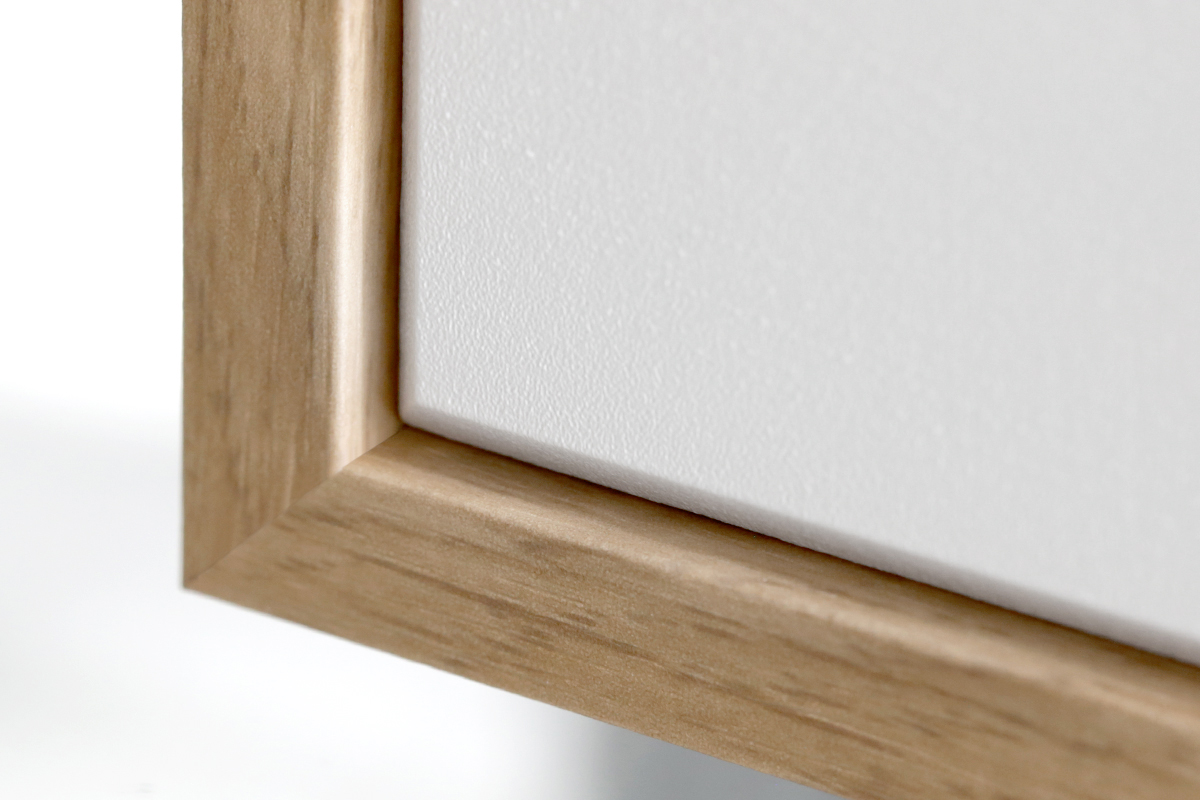
The speakers have vinyl-wrapped MDF enclosures and come with racetrack-shaped, magnetically attached woven-cloth grilles. The grilles cover the drivers but leave part of the front baffles exposed. At the bottom of the front baffle is the Triangle name, spelled out in caps. This is visible whether or not the grilles are attached. In the upper-right corner of the primary speaker is a small LED that glows different colors to indicate the selected input. Each speaker measures 8.1″W × 14.1″H × 12.4″D. The primary speaker weighs 16.8 pounds and the secondary speaker weighs 14.6 pounds.
Five finishes are available. The Oak Green version has a dark-oak enclosure and dark-green front baffle and grille. The Light Oak model has a cream-colored baffle and grille, while the Light Oak Blue model has a dark-blue front baffle and grille. The Cream version has a cream-colored cabinet, front baffle, and grille; and the Black version has a black wood-effect cabinet, flat-black baffle, and woven black grille. My review sample had the Light Oak finish. I thought the fit and finish was commensurate with the price, but I found the design very distinctive.
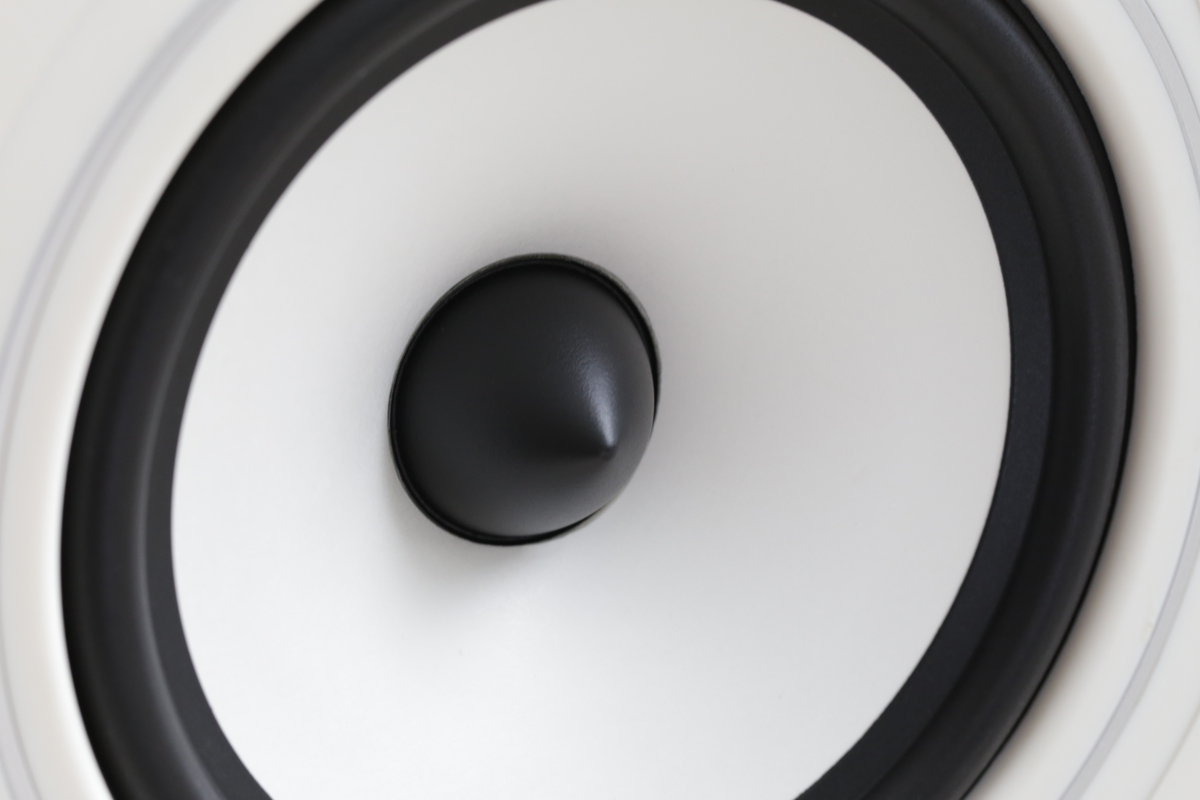
Each speaker contains a 6.5″ midrange-woofer with cellulose paper cone, 1″ silk-dome tweeter, and a second-order passive crossover centered on 3.6kHz. The midrange-woofer has a white cone, with a black dust cap in the center and black surround around the perimeter. In front of the black tweeter dome is a silver-colored metallic phase plug that extends vertically from below and above the dome. Both drivers are surrounded by a decorative ring. The visual effect is very striking.
The enclosures are almost identical in appearance to Triangle’s Borea BR03 passive speakers, except for two things. The twin bass ports are at the top of the rear panel on both the primary and secondary speakers on the BR03 BT, rather than at the bottom of their front baffles, and the passive BR03 speakers have rectangular grilles that cover their entire front baffles.
In addition to the two bass ports, the back panel of the Borea BR03 BT’s secondary speaker has a pair of binding posts that accept speaker-level audio from the primary speaker. Triangle supplies a 3m (9.8′) stripped and tinned speaker cable with the system. One caution: the polarity marking on this cable is very faint, making it more challenging to connect the speakers in phase.
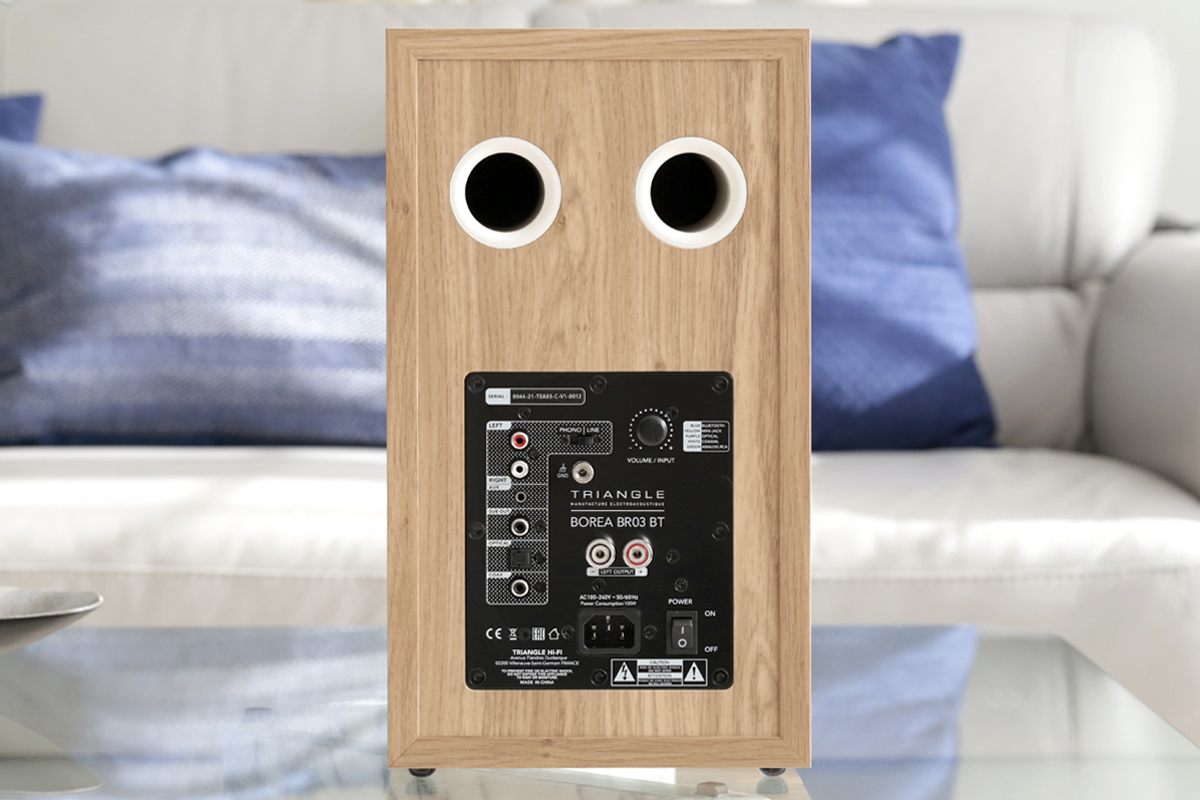
Below the bass ports on the back of the primary (right) speaker is a jack panel with a pair of RCA inputs, switchable between line-level and phono operation, as well as a ground terminal for use with a turntable; a 3.5mm mini stereo line-level input; a subwoofer output jack (RCA); and optical S/PDIF (TosLink) and coaxial S/PDIF (RCA) inputs. One bit of weirdness: the RCA left-channel jack is red, and the right-channel jack is white, the opposite of conventional color coding. On the upper right of the connection panel is a rotary control—turn it to adjust volume, push it to cycle through sources. In the center of the jack panel is a pair of binding posts for sending speaker-level audio to the left speaker, and below it, a three-prong IEC power inlet. The primary speaker also contains a Bluetooth receiver that supports the SBC, AAC, aptX, aptX HD, and aptX low-latency codecs. The subwoofer jack outputs a full-bandwidth summed mono signal. If you’re connecting a sub, you have to use its crossover control to engage a low-pass filter.
The Borea BR03 BT system comes with an RF remote control with volume, source selection, track control, and mute functions. The track controls only work with Bluetooth. There are also buttons for adjusting bass and treble, plus an EQ reset button for restoring the default neutral setting. A three-second press on the Bass+ button activates loudness compensation, and a three-second press on the Bass– button deactivates it. The LED on the right speaker flashes briefly to confirm these adjustments. Loudness compensation boosts bass output at low volume settings. The amount of bass boost that the loudness setting provides on this system is very well judged—I never found it excessive. At medium and high levels, there’s no bass boost when loudness compensation is turned on—which is exactly as it should be.
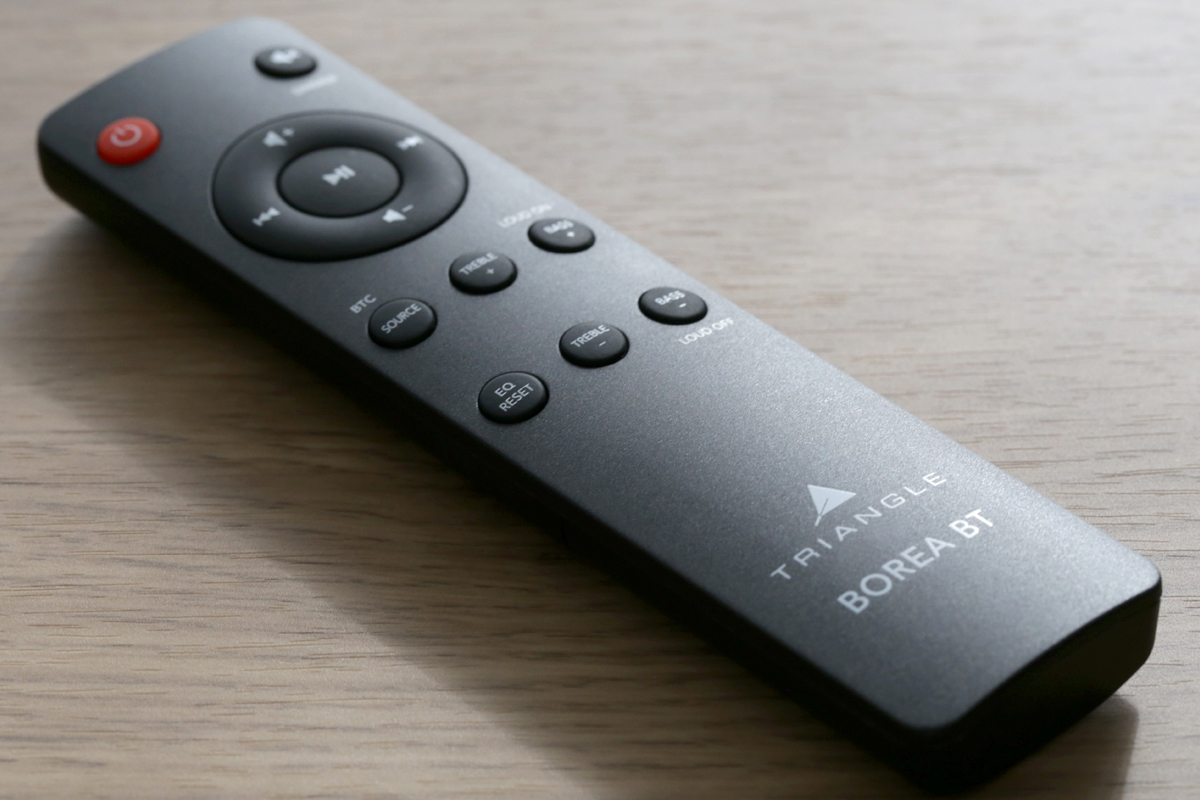
The powered Borea speakers come with a manual with French and English instructions. The manual covers most functions well, except for the loudness function, which is not very well explained.
Listening
After unpacking the Borea system, I played music at moderate levels for about 12 hours, just to run the speakers in. That task complete, I placed the Triangle speakers on 28″ sand-filled MDF speaker stands on either side of the electric fireplace in our living room. The speakers were 7′ apart and 7.5′ from my listening position on the end cushion of our sectional sofa on the opposite wall. The rear panels of the speakers were 16″ from the wall behind them. I connected my Pro-Ject Debut Carbon Evo turntable ($869 CAD with Ortofon 2M Red cartridge) to the primary speaker’s RCA inputs and Andover Audio’s tiny Songbird streamer ($179) to the optical S/PDIF input.
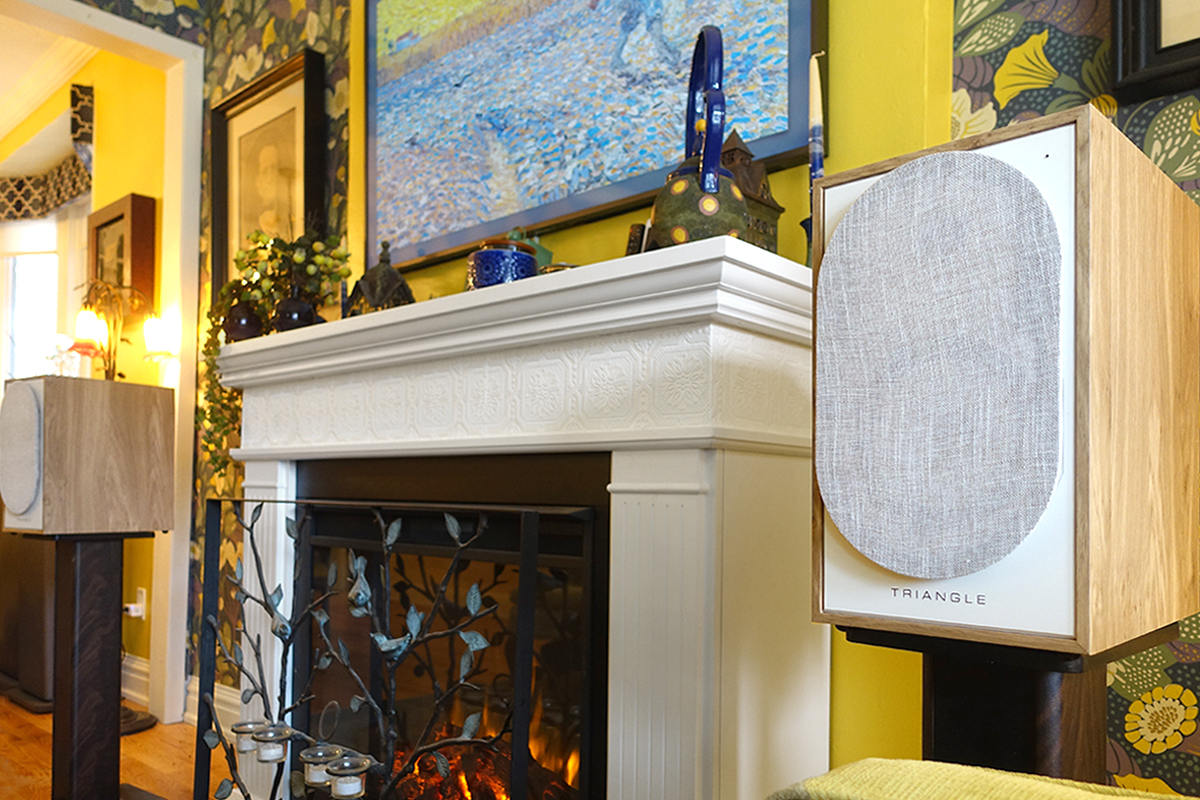
The last recording I played through my KEF LS60 Wireless active speaker system before shifting them aside and moving the Triangle speakers into place was Perpetuum, by the Australian pianist Anthony Romaniuk (24-bit/192kHz FLAC, Alpha Classics / Qobuz). On this album, Romaniuk plays music by a wide range of composers, ranging from J.S. Bach and Franz Schubert to Philip Glass and John Adams, all on different instruments.
The first track, “China Gates,” by the American minimalist composer John Adams, is played on a midsize Fazioli F228 grand piano. The second, “Danses de travers No. 1” from Erik Satie’s Pièces froides, is played on an 1835 Conrad Graf fortepiano. The third, a prelude by J.S. Bach, is played on a Yamaha CP-80 electric piano.
On “China Gates,” the powered Boreas conveyed the full, warm tone and super-long decay of the Fazioli piano. Romaniuk’s light, skipping attacks segued into luxurious sustains that went on and on and on. It was gorgeous. The speakers completely disappeared—they threw an immense soundstage with gobs of depth. Low notes had impressive authority, and high notes had the gentle clarity characteristic of a Fazioli instrument. The microdynamics were very good, so that it was easy to hear Romanuik’s varied touch.
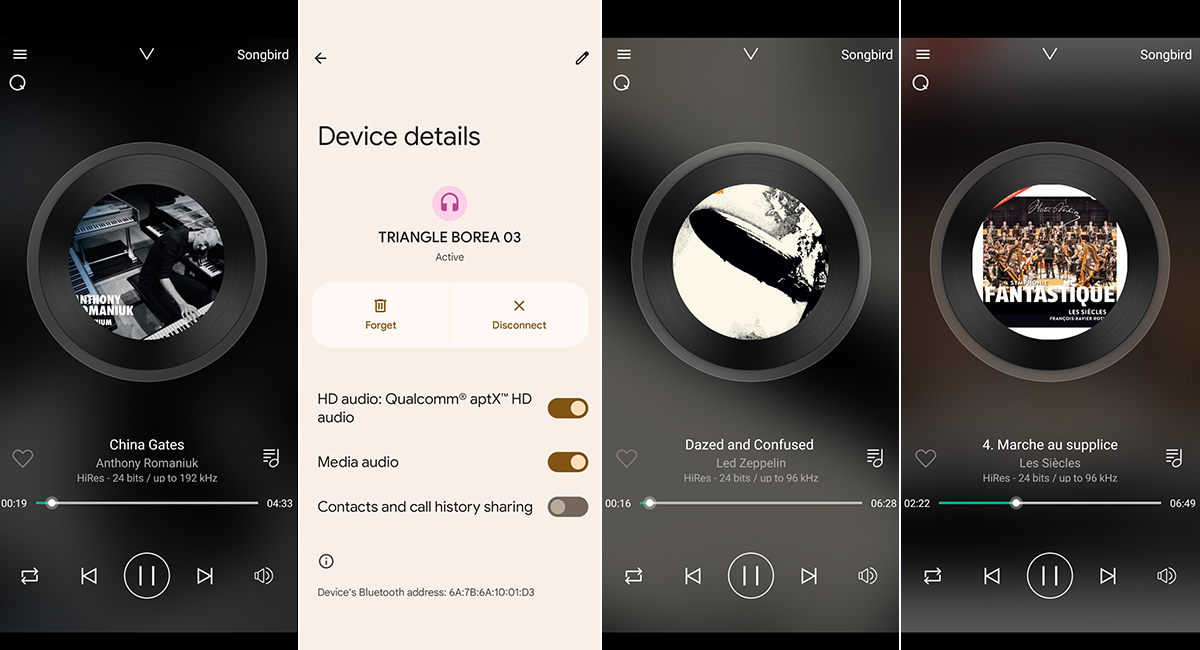
On the Satie piece, the Borea speaker system delivered the crisp attacks and harmonic richness characteristic of a 19th-century fortepiano. On both the Adams and Satie compositions, the characteristic tonality of the two instruments was accurate and consistent throughout their entire ranges.
The Bach was different, as it’s played on an electric piano. The phrasing was clipped, with fast leading edges and truncated decays. Each note was well differentiated from those around it, so that I could follow the fast runs. Especially in the lower register, the Yamaha instrument produces an electronic tonality vaguely reminiscent of Wendy Carlos’s analog synthesizer on her 1968 Switched-On Bach album, and the powered Boreas reproduced it beautifully.
I’d expected to be let down when I switched from my reference active floorstanders to a pair of powered standmount speakers one-eighth the price, especially when I listened to the very same music. The KEFs delivered these pieces with a greater sense of ease and scale, conveying Romaniuk’s dynamic shading more clearly, and threw an even vaster soundstage. The low notes had more authority through the LS60 Wireless system as well; you’d expect all that given the difference in size, price, and design. But here’s the thing: I never felt I was slumming when I was listening to the Triangles. Quite the opposite—I remained immersed in the music. A truly auspicious beginning.
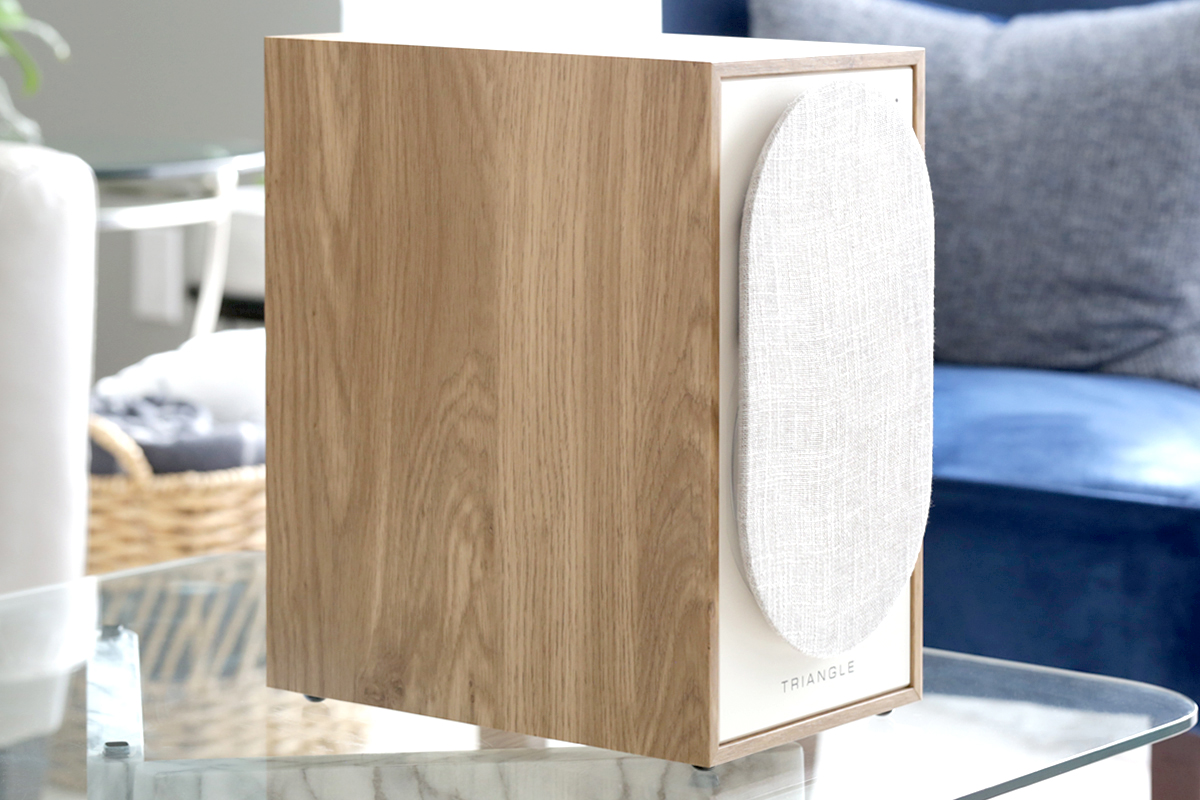
I had been streaming an uncompressed hi-rez version of Perpetuum to the Songbird streamer and Borea speaker system. I wanted to compare this with a Bluetooth stream, so I switched the powered Boreas to the Bluetooth input and paired the system with my Google Pixel smartphone. After confirming that the phone and speakers were using the premium aptX HD codec, I listened to “China Gates” again. Compared to the uncompressed stream, there was less space around the notes when I used Bluetooth. The sound was just a little drier, a little less filled-in, with the Bluetooth connection. The tonality of the Fazioli grand piano was a little fuller and warmer though the Songbird. But I don’t want to overstate the difference. The Bluetooth stream was immensely satisfying. While I wouldn’t hesitate to use Bluetooth to play music through this system, I’d listen to an uncompressed stream if I had the choice.
Clearly, the powered Boreas could handle the artsy stuff, but how would they perform with more intense fare? Very well indeed, as I confirmed by streaming “Dazed and Confused” from the remastered 2014 version of Led Zeppelin’s debut album (24/96 FLAC, Atlantic Records / Qobuz) to the Songbird. John Paul Jones’s pounding bass guitar lines and John Bonham’s ferocious drumming sounded bigger and more powerful than I’d expected from these affordably priced standmount speakers. The powered Boreas were just as impressive higher up in the audioband. Cymbal attacks were fast and ideally metallic, but not splashy. The leading edges of Jimmy Page’s guitar notes during his solos were razor sharp, and during the big choruses, his furious chords exploded into my living room. Robert Plant’s impassioned singing sounded completely natural, and the Boreas delivered his quivery and raspy accents with admirable precision. Consonants were crisp, with no hint of spittiness. Even in the big wall-of-sound sections, the Triangle system displayed no sign of distress.
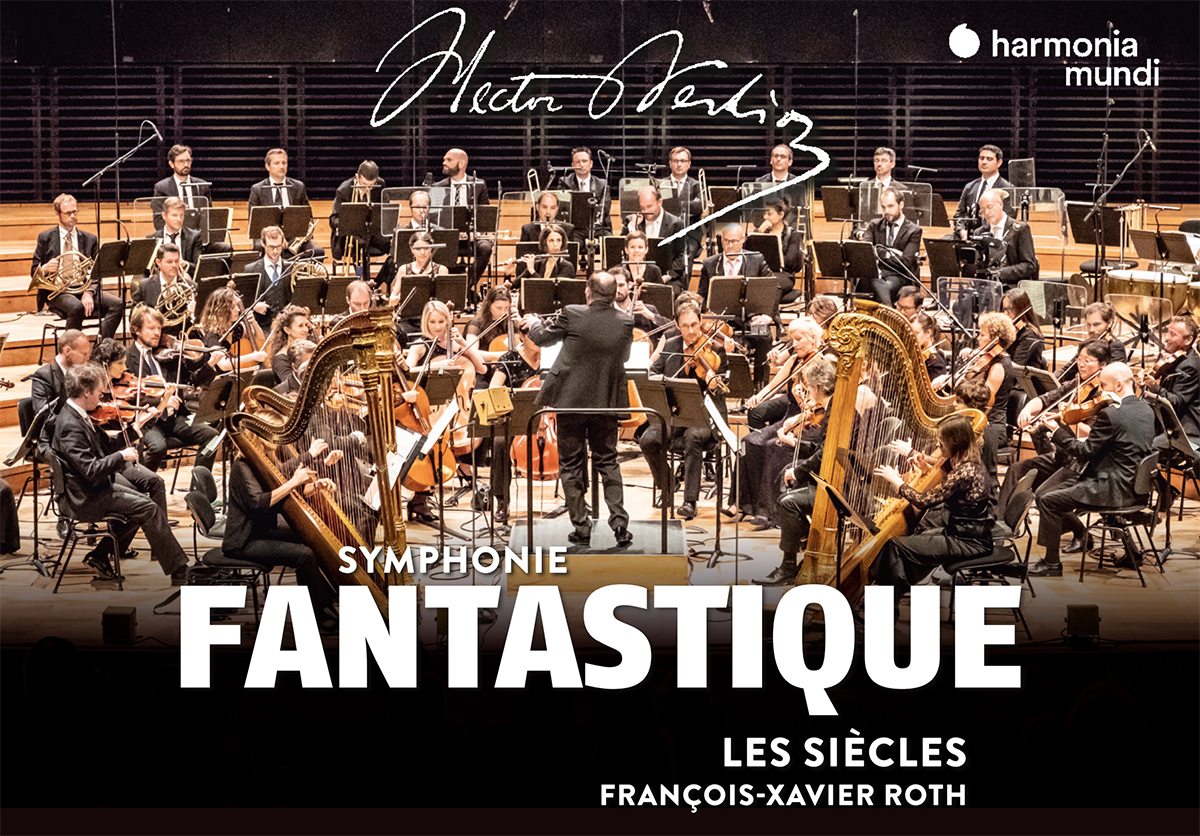
The powered Boreas also showed their dynamic prowess in a thrilling performance of Hector Berlioz’s Symphonie fantastique by Les Siècles, conducted by François-Xavier Roth (24/44.1 FLAC, Harmonia Mundi / Qobuz). As on all their recordings, Les Siècles used period instruments in this 2019 live performance. It was recorded at the Maison de l’Orchestre National d’île-de-France in Paris.
The fourth movement, “Marche au supplice” (“March to the Scaffold”), opens quietly, with bass drum and timpani rolls in the right rear of the soundstage, and the trombones and bass ophicleides intoning ominously off to the left. (Originating in 19th-century France, the ophicleide is a low-pitched brass instrument; tubas play this part in modern performances.) The drums had marvelous palpability—I could clearly hear the impacts of the mallets on the drumheads, and then the resonance of the drum bodies, followed by the extended reverberation through that Parisian concert hall. And I could sense the subtle blasts of air from the brass instruments, which had a deep, golden tone.
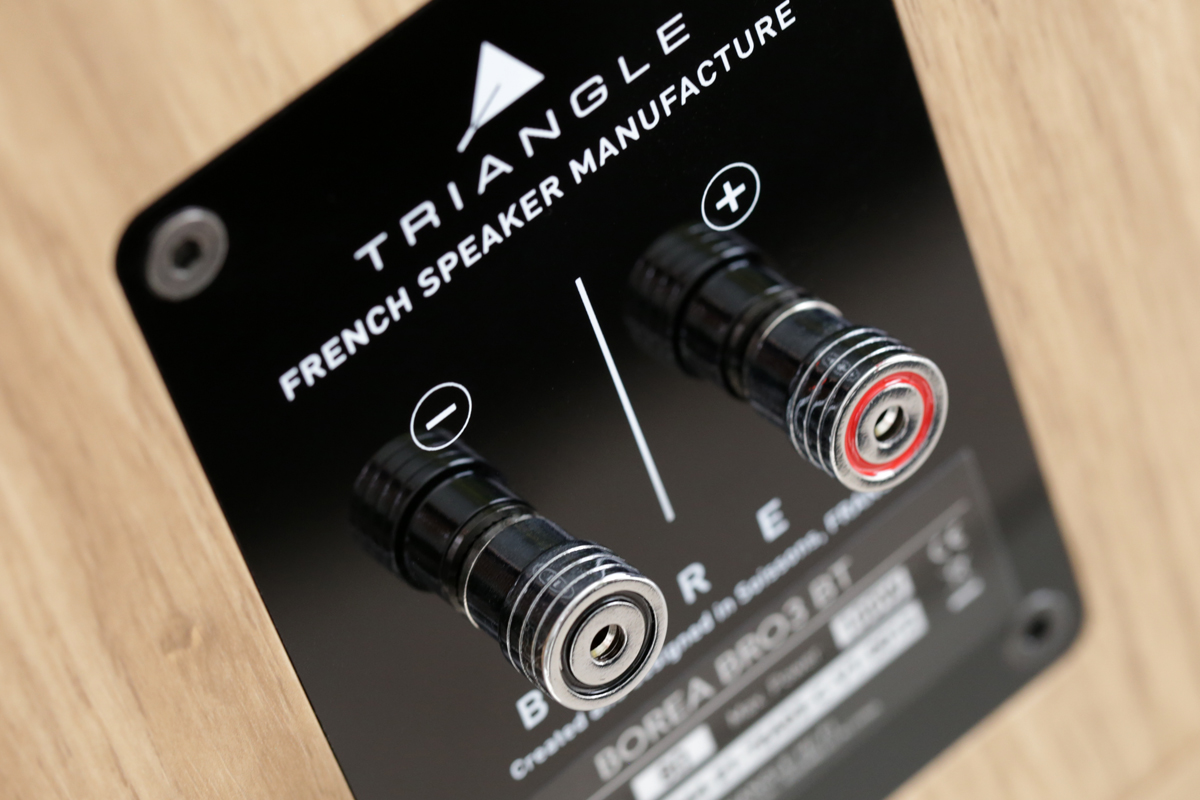
Thirty seconds in, the drama ramps up big time, with three rapid pizzicato notes followed by a huge timpani roll. The Triangle speaker system delivered it effortlessly, and kept up the performance throughout the furious passage that followed. Cymbal crashes were fast and dramatic, but not splashy; brass instruments blared impressively without sounding strident. I could hear the blasts of air from the bells on the horns and trumpets. In the mad, intense marching passages, the Boreas separated the orchestral strands impressively, so I could hear right into the score. The sound never became thick or congested, even when the whole orchestra was playing fortissimo.
I loved the way the powered Boreas rendered the colorful tonalities of the period instruments. Cellos and double basses had a wonderful breathy growl. The antique violins, played with minimal vibrato, had a lovely, silvery tone. I could clearly sense the pressure of the bows on the strings, but this effect was not spotlit.
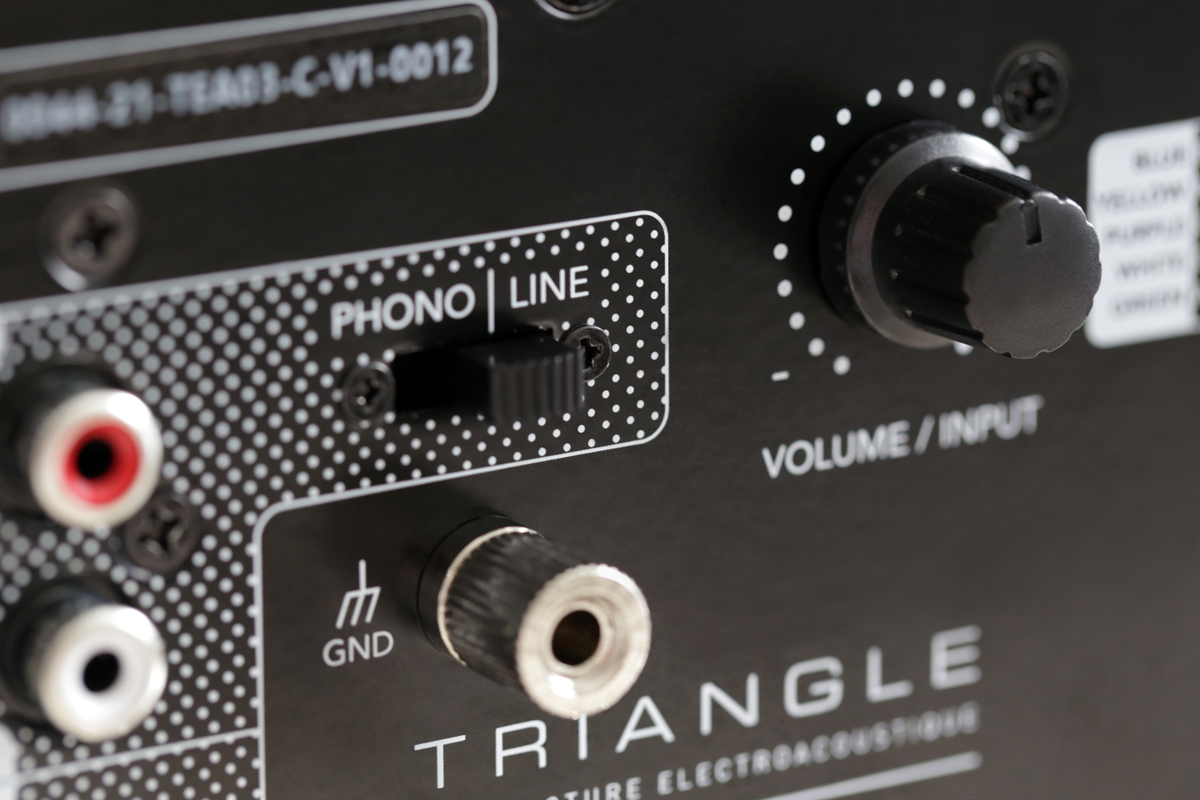
To assess the Borea system’s phono stage, I plunked one of my desert-island records on my Pro-Ject ’table: Landfall by Laurie Anderson and Kronos Quartet (Nonesuch 564164-1). Before lowering the tonearm onto the record, I set the volume of the BR03 BT system to a medium-high level and listened with my ear about a foot from the right speaker. All I heard was a very faint hiss; further away, noise was inaudible. This is a very quiet phono section.
Landfall relates Anderson’s experience of Hurricane Sandy, which struck New York City in October 2012. The first track, “CNN Predicts a Monster Storm,” begins with two violins playing a spooky, foreboding theme, underpinned by drone notes played on viola and cello. The tonality of the Kronos strings was nigh-on perfect. The violins sounded sweet and extended, and the viola and cello were rich and resonant. I could hear the action of the bows on the strings, but the sound was not scrapy or excessively rosiny. Later in the track, I admired the pizzicato notes on the cello. The attacks on the upper and lower strings were fast but not spotlit, and the decays had loads of body, but no bloat. Each instrument had a precise location on a wide, deep soundstage.
In the fourth track, “Our Street Is a Black River,” Anderson describes Sandy’s initial impact on the city. Her spoken narration in the front of the soundstage, just to the right of the center, was completely natural—like she was in the room describing her experience. Consonants were clear, but not spitty or hot. The deep synth notes that punctuate the track were powerful and threatening, but also a bit boomy. I’m inclined to attribute the boominess to my listening room. As I’ve frequently mentioned before, my living room has some nasty standing waves. But two taps on the Bass- button on the remote tamed that boominess a lot—without harming the overall balance. As before, I loved the way the Boreas rendered the Kronos strings—the rich woodiness of the cello and viola, the silvery high notes of the violins.
Comparisons
I compared the powered Boreas with two other speaker systems that have built-in amplification: Elac’s Debut ConneX DCB41 ($599.98/system) and SVS’s Prime Wireless Pro ($899.99/system).
Like the Borea BR03 BT, the Debut ConneX DCB41 is a powered speaker system, with a conventional passive crossover that comes after the amplifier in the signal path. And like the Triangle system, the Elac system has a pair of RCA input jacks that can be switched between line-level and phono operation, an optical S/PDIF (TosLink), and a subwoofer output jack. But the DCB41 also has a USB input for connecting a computer and an HDMI ARC port for connecting an HDTV. Each enclosure houses a 4.5″ polypropylene midrange-woofer and 0.75″ soft-dome tweeter powered by a 50Wpc class-D amp in the primary speaker.

Playing the Landfall LP through the Elacs, the tone of the violins in “CNN Predicts a Monster Storm” was a tad steelier through the Elac system, but still very good. However, the drone notes from the viola and cello were less pronounced, and the pizzicato notes of the cello fainter and less rich. Activating the system’s XBass setting helped matters, but even in the maximum setting, those deep cello notes weren’t nearly as rich as they were through the Triangles. On “Our Street Is a Black River,” the deep synth notes were much fainter than they were through the Triangle system, even with XBass at the high setting. On both tracks, the Elacs threw a slightly wider and higher soundstage. However, the sound was more dynamically compressed and a little harder at high volumes.
The difference in output and bass response should come as no surprise. The area of the Elac system’s woofer cones is half that of the Triangle’s. The volume of the Borea’s enclosures is almost four times greater than the little ConneX system. The Elac system is more suited for nearfield listening in a den or home office than sit-back listening in a living room.
The SVS Prime Wireless Pro is an active system, with a 5.25″ polypropylene midrange-woofer and 1″ aluminum-dome tweeter in each speaker, with each driver powered by its own 50W class-D amplifier. The DSP-enabled crossover comes before the amplifiers in the signal path. Unlike the Borea BR03 BT system, the Prime Wireless Pro does not have a phono stage. But it has an HDMI ARC interface, which the Triangle system lacks, as well as a network streamer based on DTS’s Play-Fi technology.
On Led Zeppelin’s “Dazed and Confused,” the SVS speaker system created a wider, deeper soundstage with better front-to-back layering and more precise placement of aural images. Jones’s electric bass and Bonham’s kickdrum beats did not sound as deep or powerful as they did through the Borea speakers, but the lows were tighter and better controlled. Through the SVS system, Plant’s voice sounded further forward in the mix, which I enjoyed, but also a tad edgier. In the furious wall-of-sound sections, the SVS system was a little harsher and more congested than the Borea system, and more dynamically compressed.
Conclusion
By now, it should be clear that Triangle Hi-Fi’s Borea BR03 BT powered speaker system is “a mighty sweet deal,” as I stated in my introduction. The Borea BR03 BT doesn’t have as many connectivity options as some of its competitors. But along with line-level analog and S/PDIF inputs (both coaxial and digital), it has a very quiet phono stage and a Bluetooth receiver that supports the premium aptX HD codec.
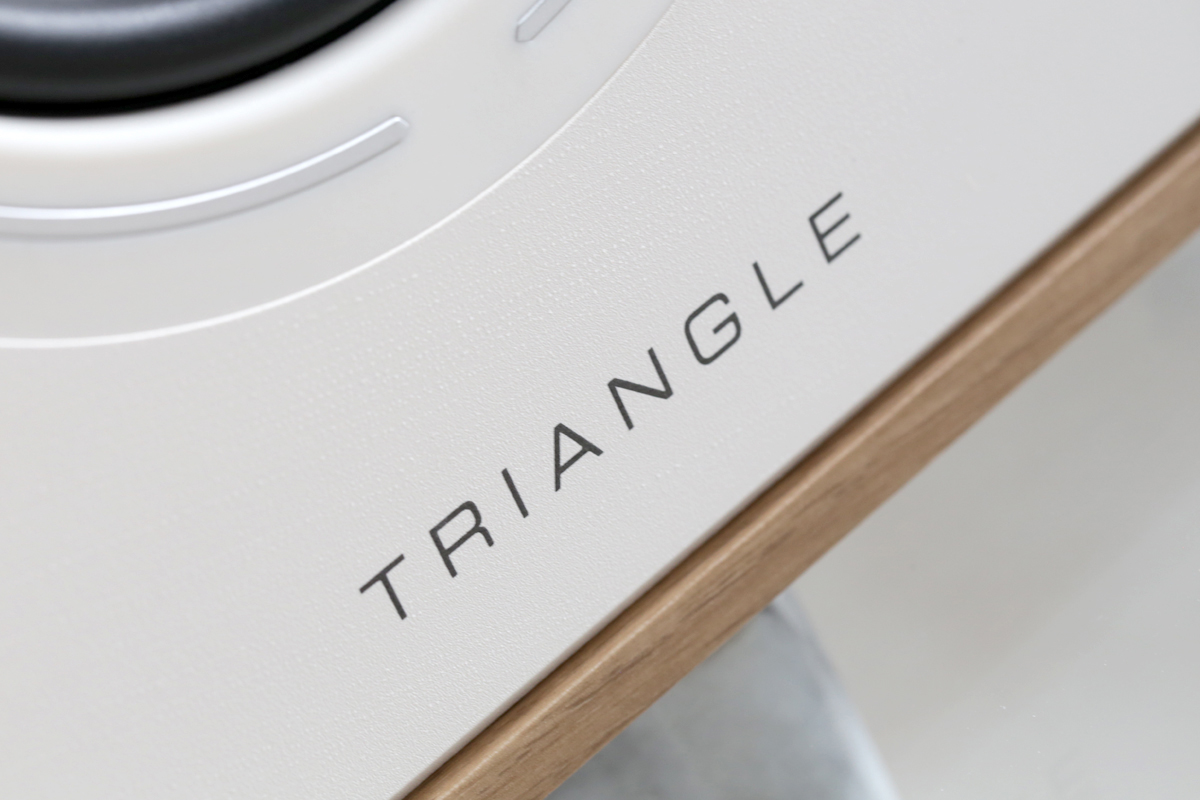
And it sounds great. Throughout my listening, I was won over by the natural vocal and instrumental timbres, effortless dynamics, and surprisingly powerful bass. Usually, I expect that reviewing a budget music system will be a bit of a chore, because I miss listening to my main system. That didn’t happen with the Borea BR03 BT. Time and time again, I slipped out of reviewer mode and just basked in the music. Isn’t that what hi-fi is all about?
. . . Gordon Brockhouse
Associated Equipment
- Powered loudspeaker system: Elac ConneX Debut DCB41.
- Active loudspeaker system: SVS Prime Wireless Pro.
- Speaker stands: BQKOZFIN (28″, floor).
- Turntable: Pro-Ject Debut Carbon Evo with Ortofon 2M Red cartridge.
- Streamer: Andover Audio Songbird.
- Smartphones: Google Pixel 4a 5G, Apple iPhone 14.
Triangle Borea BR03 BT Powered Loudspeaker System
Price: $799 per system.
Warranty: One year, parts and labor; three years with product registration.
Triangle Hi-Fi
475 avenue Flandres Dunkerque 1940
02200 Villeneuve-Saint-Germain
France
Website: www.trianglehifi.com



